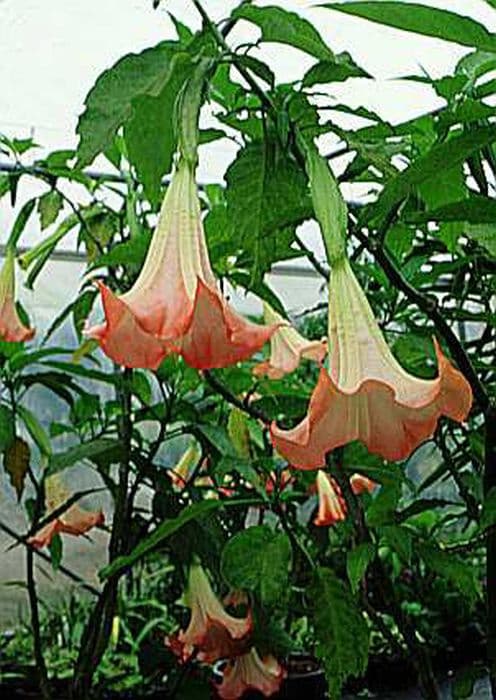Million Bells Calibrachoa Aloha Classic Tiki Soft Pink = 'Duealtisopi' (PBR) (Aloha Classic Series)
![calibrachoa [Aloha Classic Tiki Soft Pink]](/_next/image?url=https%3A%2F%2Fplants-admin.emdemapps.com%2Fimages%2Fplants%2F%2Fimages%2F604b548e0a5ef.png&w=3840&q=75)
ABOUT
The Calibrachoa Aloha Classic Tiki Soft Pink, also simply known as Calibrachoa, displays a cascade of delicate pink blooms that provide a soft and inviting aesthetic. Each individual flower consists of petite, funnel-shaped blossoms with a subtle blend of soft pink hues, often featuring a darker pink or yellow throat, which adds depth and visual interest to the overall appearance. The blooms generously cover the plant, creating a full and lush look. The foliage is typically green, forming a pleasing backdrop to the charming flowers. With its trailing habit, this Calibrachoa is a popular choice for adding a splash of color in hanging baskets, containers, or as a spiller plant in mixed garden displays. Its flowering season is extensive, providing long-lasting appeal throughout the warmer months.
About this plant
 Names
NamesSynonyms
Million Bells, Mini Petunia
Common names
Calibrachoa 'Duealtisopi'
 Toxicity
ToxicityTo humans
Calibrachoa, commonly known as "Million Bells," is not known to be toxic to humans. There is limited information on the toxicity of this specific hybrid to humans, but the genus Calibrachoa is generally considered to be non-toxic. As a result, ingestion of the Calibrachoa Aloha Classic Tiki Soft Pink should not result in poisoning or produce any symptoms. However, it is always advisable to prevent the ingestion of any part of ornamental plants.
To pets
Calibrachoa, commonly known as "Million Bells," is not known to be toxic to pets. Similar to the information available for humans, there is generally limited information on the toxicity of this specific hybrid to pets, but the genus Calibrachoa is largely considered to be non-toxic. Therefore, ingestion of parts of the Calibrachoa Aloha Classic Tiki Soft Pink by pets is unlikely to cause poisoning or result in symptoms associated with toxicity. Nevertheless, it is still best to discourage pets from consuming any part of ornamental plants.
 Characteristics
CharacteristicsLife cycle
Annuals
Foliage type
Evergreen
Color of leaves
Green
Flower color
Soft Pink
Height
1 feet 4-10 inches (40-50 cm)
Spread
1 feet 8-14 inches (50-60 cm)
Plant type
Herb
Hardiness zones
9
Native area
South America
Benefits
 General Benefits
General Benefits- Attractive Blooms: Features soft pink flowers that add a delicate touch of color to gardens and outdoor spaces.
- Continuous Flowering: Blooms from early spring to the first frosts, providing long-lasting visual appeal.
- Compact Growth: Has a mounded, trailing habit that makes it ideal for hanging baskets, containers, and small garden spaces.
- Low Maintenance: Requires minimal care, making it suitable for gardeners of all skill levels.
- Drought Tolerant: Once established, it can withstand periods of low water, reducing the need for frequent watering.
- Frost Tolerant: Can survive light frosts, which extends its growing season in cooler climates.
- Attracts Pollinators: The flowers can attract beneficial insects such as bees and butterflies to the garden.
- Versatile Usage: Can be used in a variety of garden designs, including borders, mixed containers, and as ground cover.
 Medical Properties
Medical PropertiesThis plant is not used for medical purposes.
 Air-purifying Qualities
Air-purifying QualitiesThis plant is not specifically known for air purifying qualities.
 Other Uses
Other Uses- Photography Prop: The soft pink blooms provide a delicate background or focal point for macro and nature photographers.
- Artistic Inspiration: Artists may use the Calibrachoa as a muse for paintings, drawings, and textile designs due to their vibrant colors and patterns.
- Educational Tool: These plants can be used in biology classes to teach students about pollination, plant growth, and hybridization techniques.
- Fauna Attraction: In a garden setting, this plant can attract hummingbirds and beneficial insects, contributing to local biodiversity.
- Themed Event Decoration: For occasions such as weddings or garden parties, these flowers can provide a consistent color theme and natural decor.
- Culinary Decoration: Although not consumed, the flowers can be used as non-toxic decorative elements on cakes and desserts.
- Handmade Crafts: The blooms can be used to create natural dyes for fabrics or pressed flowers for scrapbooking and card making.
- Seasonal Celebrations: The Calibrachoa's vibrant pink color can be incorporated into festive decorations for events such as Easter or spring celebrations.
- Petal Confetti: Dried petals of the Calibrachoa can serve as biodegradable confetti for outdoor celebrations, reducing environmental impact.
- Children’s Gardening Education: These plants can be used to create a sensory experience for children, teaching them about plant care and responsibility.
Interesting Facts
 Feng Shui
Feng ShuiThe Calibrachoa is not used in Feng Shui practice.
 Zodiac Sign Compitability
Zodiac Sign CompitabilityThe Calibrachoa is not used in astrology practice.
 Plant Symbolism
Plant Symbolism- Charm and Grace: The soft pink color of Calibrachoa is often associated with gentleness and the conveyance of a charming gracefulness.
- Youthful Energy: The vibrant growth and bountiful blooms of Calibrachoa can symbolize youthful energy and a zest for life.
- Celebration: Calibrachoa flowers, similar in appearance to festive confetti, often represent celebration and festivities, making them perfect for cheerful occasions.
- Friendship: The bright, appealing flowers are also used to symbolize strong bonds of friendship due to their warm and inviting presence in a garden.
 Water
WaterMillion Bells should be watered regularly to maintain moist but not waterlogged soil. They thrive with a consistent watering schedule, ideally receiving about an inch of water per week. During hot, dry periods, they may require more frequent watering, such as every other day, to prevent the soil from drying out completely. If grown in containers, they may need watering daily, especially if the weather is warm and windy. Check the soil moisture regularly, and when the top inch of the soil feels dry to the touch, water deeply with about half a gallon per square foot of soil area to encourage robust root growth.
 Light
LightMillion Bells perform best in full sun conditions, which means they should receive at least 6 to 8 hours of direct sunlight each day. Ideally, plant them in a location where they are exposed to morning sunlight and have some protection from the intense afternoon sun, especially in hotter climates. They can tolerate light shade but flowering may be reduced in less than optimal sunlight conditions.
 Temperature
TemperatureMillion Bells thrive in warm conditions and prefer an average daytime temperature ranging from 65 to 85 degrees Fahrenheit. They can tolerate minimum temperatures down to about 50 degrees Fahrenheit, but growth will be slowed. Maximum temperatures should not consistently exceed 90 degrees Fahrenheit as extreme heat can stress the plants. Ensure good air circulation to prevent heat stress during the warmer months.
 Pruning
PruningPruning Million Bells encourages bushier growth and more flowers. Lightly trim the plant every few weeks to promote branching, especially if it begins to look leggy or sparse. The best time to prune is in the late spring or early summer as new growth appears, but light pruning can be done throughout the growing season. Deadheading spent flowers isn't necessary as Million Bells are self-cleaning, but removing damaged or dead plant material can promote overall plant health.
 Cleaning
CleaningAs needed
 Soil
SoilMillion Bells thrive in well-draining soil with a slightly acidic pH between 5.6 to 6.0. A good soil mix would be equal parts peat moss, potting soil, and perlite to ensure proper drainage and aeration. Regular feeding with a balanced liquid fertilizer will keep them blooming prolifically.
 Repotting
RepottingMillion Bells should be repotted annually to refresh the soil and accommodate growth. If the plant becomes root-bound or the soil looks depleted, it's time to repot. Choose a container only slightly larger than the previous one to prevent overwatering issues.
 Humidity & Misting
Humidity & MistingMillion Bells prefer moderate to high humidity levels but are quite adaptable. A range of 40-70% humidity is ideal for these plants. They can tolerate lower humidity, but leaf and flower health are best with higher humidity.
 Suitable locations
Suitable locationsIndoor
Place in bright, indirect light and water when the topsoil is dry.
Outdoor
Full sun to partial shade, water regularly, and protect from frost.
Hardiness zone
9-11 USDA
 Life cycle
Life cycleThe Calibrachoa 'Duealtisopi', commonly known as the Calibrachoa Aloha Classic Tiki Soft Pink, initiates its life cycle from a seed or cutting, where it then germinates or roots in a warm, moist environment. After sprouting, it enters the vegetative stage, growing stems and leaves rapidly in preparation for flowering, optimally in full to partial sunlight and well-drained soil. The plant reaches maturity and begins the reproductive phase with the development of vibrant pink, trumpet-shaped flowers, which attract pollinators for seed production or can be propagated asexually through cuttings. Following pollination, the plant produces small, non-descript seeds that can be collected for future propagation. As temperatures drop or growing conditions become less favorable, the Calibrachoa may enter a period of dormancy or die back, particularly in areas where it is not hardy. Many gardeners treat Calibrachoa as annuals, replacing them each year, although they can survive as perennials in USDA hardiness zones 9 through 11.
 Propogation
PropogationPropogation time
Spring-Early Summer
The Calibrachoa Aloha Classic Tiki Soft Pink, also known simply as Calibrachoa or million bells, is typically propagated through softwood cuttings. The best time for this method is during late spring to early summer when the plant is actively growing. A gardener will select healthy, non-flowering stems and cut a 4 to 6 inch (10 to 15 cm) section just below a leaf node. The lower leaves are removed, and the cutting is dipped in a rooting hormone to encourage root development. The cutting is then inserted into a moist potting mix or directly into the ground in a protected area with indirect sunlight. Consistent moisture and warmth support the rooting process, which generally takes a few weeks before the cuttings are well-rooted and ready to transplant.


![Calibrachoa [Aloha Classic Blue Sky]](/_next/image?url=https%3A%2F%2Fplants-admin.emdemapps.com%2Fimages%2Fplants%2F%2Fimages%2F604b636c3778b.png&w=640&q=75)
![Calibrachoa [Aloha Classic Gold]](/_next/image?url=https%3A%2F%2Fplants-admin.emdemapps.com%2Fimages%2Fplants%2F%2Fimages%2F604b6284c573e.png&w=640&q=75)
![Calibrachoa [Cabaret Deep Yellow]](/_next/image?url=https%3A%2F%2Fplants-admin.emdemapps.com%2Fimages%2Fplants%2F%2Fimages%2F604b5f20ca3ef.png&w=640&q=75)
![Calibrachoa [Calibasket Radiant Orange]](/_next/image?url=https%3A%2F%2Fplants-admin.emdemapps.com%2Fimages%2Fplants%2F%2Fimages%2F604b536d43cb2.png&w=640&q=75)
![Calibrachoa [Caloha Classic Blue Velvet]](/_next/image?url=https%3A%2F%2Fplants-admin.emdemapps.com%2Fimages%2Fplants%2F%2Fimages%2F604b604884a75.png&w=640&q=75)
![Calibrachoa [Caloha Classic Honey White]](/_next/image?url=https%3A%2F%2Fplants-admin.emdemapps.com%2Fimages%2Fplants%2F%2Fimages%2F604b5f56e0beb.png&w=640&q=75)
![Calibrachoa [Caloha Classic Yellow Chocolate Ring]](/_next/image?url=https%3A%2F%2Fplants-admin.emdemapps.com%2Fimages%2Fplants%2F%2Fimages%2F604b538aede95.png&w=640&q=75)
![Calibrachoa [Caloha Grand Purple]](/_next/image?url=https%3A%2F%2Fplants-admin.emdemapps.com%2Fimages%2Fplants%2F%2Fimages%2F604b6192993d2.png&w=640&q=75)